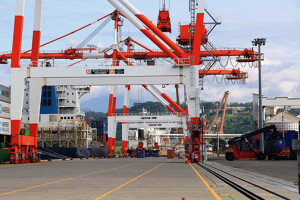
Subic Bay International Terminal Corp (SBITC) is “investing heavily in equipment” in order to keep pace with volume growth at its New Container Terminals (NCT) 1 and 2, according to general manager Roberto Locsin.
Locsin, who was a guest at the November 5 general membership meeting of the Association of International Shipping Lines (AISL) along with Subic Bay Metropolitan Authority (SBMA) chairman Roberto Garcia, said yard utilization at NCT 1 is now around 52%, hitting 53% during its “heaviest days” this year (first weekend of November).
Before implementation of the Manila daytime truck ban that triggered massive port congestion, Subic port suffered from low yard utilization. The steady increase in use of the facility reflects shippers’ need to look for an alternative to clogged Manila ports.
By the end of November, Locsin said, a total of three additional reach stackers will join three existing ones and three empty handlers.
Also for delivery are supporting chassis, forklifts and other equipment. In addition, new terminal tractors are arriving, bringing the total to 16 by January 2015.
Locsin said the port can accommodate “one or two more big customers until (the terminal) receives two new RTGs (rubber-tired gantries) by the second half of next year”. By 2016, the port could easily handle close to 300,000 twenty-foot equivalent units (TEUs), he added.
NCT 1 and NCT 2 have a combined annual capacity of 600,000 TEUs.
The SBITC executive said the terminals are now operating 24/7 with its workforce operating on two shifts; there are also plans to double the workforce.
Meantime, Locsin said current equipment can satisfy volume at the facilities.
He noted SBITC, a subsidiary of International Container Terminal Services, Inc. (ICTSI), operator of the Manila International Container Terminal (MICT), is careful to manage its volume growth in order to avoid “replicating” congestion experienced at the Manila ports.
From January to October 2014, container traffic at Subic port surged 65.39% to 51,918 TEUs from 31,391 TEUs in the same period last year. SBMA targets 70,000 TEUs for Subic this year.
SBMA chairman Garcia said that of the 3 million containers handled yearly by Manila ports, 15%, or 450,000 TEUs, originate from or are destined for Central and Northern Luzon.
“It therefore does not make any sense at all why these 450,000 (TEUs) should clog up the streets of Metro Manila when Subic Port is willing and able to accept that volume,” he told AISL members.
The AISL meeting was also attended by Bureau of Customs collector General Arnulfo Marcos and Subic-Clark Alliance for Development executive director Erlinda Pamintuan. PortCalls covered the event.
SBITC, together with SBMA, the government agency overlooking operations at the Subic Bay Freeport where NCT 1 and 2 are located, is likewise working on streamlining the process of accommodating trucks.
Currently, there are three gates at the terminals, but an additional four will be opened by the middle of 2015 that will lead to “better productivity to match productivity at the yard,” Locsin added.
In the interest of “transparency in communications”, he said a terminal report similar to that disseminated by ICTSI at the MICT will also be released so that “everyone knows what’s going on” at the Subic facility.
One-stop shop
SBITC and SBMA have also agreed to construct a building near the port housing one-stop shop operations of the Bureau of Customs (BOC) and other agencies that facilitate processing of import and export documents.
SBMA’s Garcia said they have yet to secure approval from Customs Commissioner John Phillip Sevilla for the project, however. Under the original plan, SBMA will donate the land on which the building will be constructed by SBITC.
For now, Locsin said their terminals are “happy to take ad-hoc calls,” noting that they have been “successful with empty evacuations.”
Thousands of overstaying Customs-cleared containers were previously diverted to Subic port as part of government measures to decongest the Port of Manila. In September, the government issued Executive Order No. 172, which designates the ports of Subic and Batangas as extensions of Manila port in times of congestion and emergency .– Roumina Pablo









